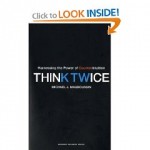This month we have a fiction entry in Book Lust by writer Barrie Abalard, who reviews the latest book in the series that inspired the Golden Globe winning “Dexter” TV series.
Want to review a book for February? Please let me know.
In the continuing discussion about e-readers I asked a hedge fund manager who follows technology to weigh in on the Kindle versus Nook choice for my birthday. He goes by “Dasan” online.  Here’s what he says.
Here’s what he says.
Happy Birthday, Tamela – I know you’ve been considering whether to buy a Nook or a Kindle. I’ve got some ideas for you.
First, the most important thing is your decision to buy an e-reader in the first place. In 20 years or less, printed-paper books will be as common as a scroll of wizardly runes is today. People will look back and wonder why books didn’t migrate to digital delivery before music and movies did. But today the question remains – to Nook or to Kindle?
You say you’re leaning toward buying the Nook because it runs on Android and you are bullish on where Android’s headed. Sorry, but you’re missing the whole point of e-readers. The point of the e-reader is to “disappear” in your hands and let you drift into that trance-like state of reading. When I’m reading Dune for the 5th time on my Kindle, I don’t even know what an operating system is. You love libraries and bookstores; that would seem to make a Nook the obvious choice, with its physical stores. Barnes & Noble has promised to let you use your nook to read books for free in their stores. Before you get too excited about that, you better look at their financial statements. Did you know that they are in the process of closing all of their B. Dalton bookstores? I wonder how long they can keep their physical stores. I loved record stores – can you find one for me? Buy a Kindle, and you don’t buy an e-reader, you buy access to the entire Amazon bookstore. But the Nook sure has a piece of hardware, with a great color second screen and that wonderful rubber backing! The decision is obvious – buy one of each!
Thanks, Dasan. Sounds like I can’t lose. I’ll let you know whether the Birthday Fairy brought me either of these.
Too Big to Fail: The Inside Story of How Wall Street and Washington Fought to Save the Financial System—and Themselves
by Andrew Ross-Sorkin, reviewed by Jim Gobetz
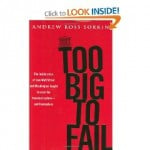 The book chronicles the events leading up to and surrounding the recent economic turmoil It is the third book on the topic I have read and by far the most exhaustive and detailed. Mr. Ross-Sorkin has unparalleled access to the key players in the events and a very flowing and easy to read writing style. He describes the characters in an unbiased manner and I came away feeling that he was quite neutral on everybody. This is a fair contrast to “The Sellout” by Charles Gasparino whose opinions of the players are obvious.
The book chronicles the events leading up to and surrounding the recent economic turmoil It is the third book on the topic I have read and by far the most exhaustive and detailed. Mr. Ross-Sorkin has unparalleled access to the key players in the events and a very flowing and easy to read writing style. He describes the characters in an unbiased manner and I came away feeling that he was quite neutral on everybody. This is a fair contrast to “The Sellout” by Charles Gasparino whose opinions of the players are obvious.
The book was good to great from cover to cover, but I am somewhat reticent to recommend it to anyone who is really not a total economy wonk like I am. The casual observer is likely to get bogged down in the details as there are literally hundreds of players and their interactions read like those of the Plantagenet’s. If you are really keen to get inside the events of 2007-2009 you won’t find better access, Mr. Ross-Sorkin has interviewed all of the key and nearly all of the ancillary players many times in his role with the NY Times. I follow the market and the political events that relate to it like a stalker, yet still I learned quite a few new things and gained new insight into the minds of the rainmakers that led us in and out (hopefully) of the debacle.
So for the fanatics, go for it, it’s a joyride through a subject you can’t get enough of. For those of a more relaxed interest, you’ll have to decide if you’re interested enough for 800 pages or so on this particular topic.
Bonus: my friend Matt Davio interviews Mr Sorkin.
Mobs, Messiahs, and Markets: Surviving the Public Spectacle in Finance and Politics
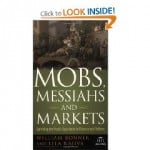 by William Bonner and Lila Rajiva, reviewed by Jim Gobetz
by William Bonner and Lila Rajiva, reviewed by Jim Gobetz
This book attempts to link the three title entities into a treatise on the human condition from which they sprang. Unfortunately the book is like a roller coaster, looping back and forth, and in and out of the topics in a way that was in my opinion uncoordinated. I am not a writer of books but I suspect a failure on the part of the editor is greatly responsible. Each chapter is interesting in and of itself but taken as a whole it makes no conclusions. The authors are at times strident and appear to be approaching a point which is never made, or they make a point that is unsupported in the context of the chapter but is in another chapter.
I have the feeling that if the book had been organized in a better fashion I might be writing a positive or even very positive review, but as is I cannot recommend it. Sadly, while the title elicits interest the text fails to deliver.
Think Twice: Harnessing the Power of Counterintuition
by Michael Mauboussin, reviewed by Derek Hernquist
Michael Mauboussin’s previous book, More Than You Know, was a collection of essays he had written under the title “The Consilient Observer”. I loved it for its discussion of the odd ways in which we process information and make decisions. Think Twice moves his work from an investor-heavy descriptions to more general prescriptions, contributing to the recent wave of books from Gladwell, Ariely, etc. on social movements.
It’s an engaging read, with countless examples of fascinating behavioral experiments. Those familiar with studies by Kahneman, Tversky, Asch, etc. will recognize many, but he also offers examples from the real world lab. Why do only 12% of Germans consent to organ donation, yet 100% of Austrians do? Because in Germany, one must opt-in, while in Austria one must opt-out…a simple difference in the way choices are presented makes a world of difference. Other examples of suboptimal decision-making abound, from Harrah’s Casino thinking high rollers are their best customers(they’re not) to a music lab giving listeners a chance to think independently about a selection of new songs(they couldn’t).
I find Mauboussin’s examples both enlightening and entertaining, but it’s this “Cliffs Notes” approach to behavioral study that defines both the strengths and weaknesses of this book. Experts in the field of psychology will already be familiar with many examples, and find the prescriptions for improving our decision-making skills too simplistic to be make a difference. For me, however, his work has been instrumental in building a constant awareness of context where snap (attribute-based) judgment had resided…a major help in accepting the potential of markets to go where the mood takes them regardless of my opinion.
Personally, I love these books and find them appropriate for 95% of the population, particularly investors, business executives, marketers, and political operatives. Both the results and implications of dozens of studies are laid out in simple form, giving the reader a vivid memory on which to construct his or her personal decision-making process. If Mauboussin’s name is new to you and you are fascinated by how we make choices, I think you’ll love Think Twice.
How God Changes Your Brain: Breakthrough Findings from a Leading Neuroscientist
b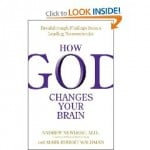 y Andrew Newberg M.D.& Mark Robert Waldman, reviewed by Wray Herbert(Washington Post’s Book World)
y Andrew Newberg M.D.& Mark Robert Waldman, reviewed by Wray Herbert(Washington Post’s Book World)
Gus was not a “meditation type of guy.” He was more of a Joe Sixpack, a Philadelphia mechanic not much interested in religion. He hauled himself into Andrew Newberg’s clinic for one reason: His memory was failing. Newberg, a neuroscientist and memory expert, has a special interest in spirituality; he has scanned the brains of worshipers ranging from Franciscan nuns to Pentecostals speaking in tongues. So why was he bothering with Gus? Well, Newberg explains in “How God Changes Your Brain,” his studies (with coauthor Mark Robert Waldman) had convinced him of a link between spirituality and cognitive health: The neurochemical changes that he observed during meditation and prayer appeared to improve brain function.
But Newberg had studied mostly devotees with years of spiritual training; he wanted to see whether a novice might benefit, too. So Gus learned the basics of Kirtan Kriya meditation. Rooted in 16th-century India, Kirtan Kriya involves conscious regulation of breathing as well as repetitive movements and sounds. Gus picked it up right away, practicing 12 minutes a day for eight weeks. That’s a blip compared to what many students of meditation do. Even so, Newberg writes, Gus had greater clarity of mind, empathy and emotional equilibrium. What’s more, his working memory improved as much as 50 percent on some tests. Gus’s case may be inspiring to readers worried about the mental decline that comes with aging. But those looking for the loftier answers promised in the book’s title may come away unsatisfied, and a bit confused. At times Newberg seems to be writing about a broad notion of spirituality, while at other times he focuses on rituals — the mantras and mudras and prayer beads — without any spiritual content or commitment. He doesn’t want to leave anyone (even atheists) outside the tent, so his definition of God is whatever any individual’s neurons are conjuring up at the moment — or the next moment or the next, because God is “constantly changing and evolving.” Inclusiveness is all well and good, but loose theology doesn’t necessarily make for rigorous testing. The second half of “How God Changes Your Brain” is a how-to book. There are lists upon lists here, and even lists within lists: eight best ways to maintain a healthy brain, including five essential reasons for yawning; nine steps for dealing with anger; six strategies for improving communication and six more for creative problem-solving. You get the idea. Aging baby boomers are hungering for good science writing on both brain health and spirituality. Happily, there are excellent books on this important topic, notably Sharon Begley’s “Train Your Mind, Change Your Brain” and Daniel Goleman’s “Social Intelligence.” Start with them. Unhappily, this bloviating volume will leave most readers still seeking.
The Moral Underground: How Ordinary Americans Subvert an Unfair Economy
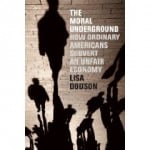 by Lisa Dodson, reviewed by Publishers Weekly
by Lisa Dodson, reviewed by Publishers Weekly
In this fascinating exploration of economic civil disobedience, Dodson (Don’t Call Us Out by Name) introduces readers to teachers, supervisors, health-care professionals and managers who bend the rules—and even break the law—to support those in need. Dodson shares stories of individuals like Linda, a health-care supervisor who has, against hospital policy, “driven an employee to court on work time” and allows her low-wage employees to manipulate the schedule so they can attend to child-care needs. The author interviews Cora, a restaurant manager, who came up with a “double talk system,” in which she keeps two sets of time sheets so that workers can attend to family issues and who says, “helping women meet their kids or do what they have to do is more important” than her chain restaurant’s rules. Dodson’s study is gripping and her argument is persuasive: we should not have to put compassionate Americans in a position where they have to choose between following rules and helping those who are trying to help themselves.
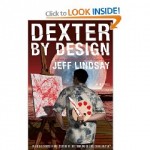 Dexter by Design (how timely, after Sunday’s Golden Globe awards)
Dexter by Design (how timely, after Sunday’s Golden Globe awards)
by Jeff Lindsay, reviewed by Barrie Abalard
Summary: A good read for Dexter fans, but not Lindsay’s best. If you’ve never read any of the “Dexter” novels, start with book one, Darkly Dreaming Dexter, in order to read this one (book four) in context. If you’ve only watched the Showtime TV series, be aware that the plots of the series and the plots of the books diverge greatly. Three and a half out of five stars.
I discovered Jeff Lindsay’s “Dexter” novels about six months before the Showtime series began. During that six months, when most of the world didn’t know the books existed, I was practically stopping strangers to rave about Lindsay’s writing and characterization. My family grew thoroughly sick of my Dexter talk. And then… the series began, with the first season repeated on one of the broadcast networks (CBS, I believe), and suddenly everyone knew what, and who, I was talking about.
Thus, Dexter by Design was a book I waited for with great impatience. And it mostly satisfies. Mostly. But it doesn’t get near the admittedly high bar Lindsay set for himself with books one and two (Darkly Dreaming Dexter and Dearly Devoted Dexter) and the slightly less spectacular but still excellent book three, Dexter in the Dark.
I believe a large part of the problem with the book’s momentum—it takes a while to get off the ground—lies in the beginning. Dexter and Rita, his new wife, are honeymooning in Paris. While Lindsay wraps up the honeymoon intro fairly well, setting the stage for the rest of the book, the story would have been stronger if he’d opened with Dexter doing his thing in Miami, as usual, and then working in remembrances of his honeymoon. I think the horror that serves as the end to the honeymoon scenes would work better if it were teased out over the first fifth of the book or so.
I also found Lindsay’s writing in the first chapter a bit irritating, before the book settles down into the sardonic commentary that is his (and Dexter’s) forte. The observations about Paris and art strike me as too floridly written, and not consistent with Lindsay’s usual clean style. I was annoyed, frankly, waiting for the real action to begin.
But, it’s not a huge quibble if you are a “Dexter” fan, which I am. Once the story returns to Miami, where Dexter works as a blood spatter analyst for the police crime lab and moonlights by taking out evil folks with his sociopathic relish, the story regains its footing. The tale is one of viciousness as well as absurdity, with some surprise turns that keep the momentum going. Unfortunately, the ending is a bit weak, as well as completely unsurprising, which disappointed me.
Lindsay’s first two books knocked my socks off. The third one, Dexter in the Dark, was only a shade less amazing. Lindsay takes chances with his main character that, in the first three books, made me gasp with surprise and pleasure as he spun plots that eventually resolved in a satisfying way. If you’re a fan of the popular homicidal character and haven’t read Dexter by Design, by all means do so, as long as you’ve read the first three books beforehand. But be prepared for that twinge of disappointment here and there.
I’ve written a series of stories with repeating characters myself, so I know it’s difficult to tell the tales and reveal new aspects of the main characters over the course of several storylines. It takes mastery of the art of fiction and a polished, smooth style, both of which Lindsay has (and I don’t, but I’m working on it). I’ll wait to read book five before I throw in the towel on Lindsay and his “Dexter” series.
